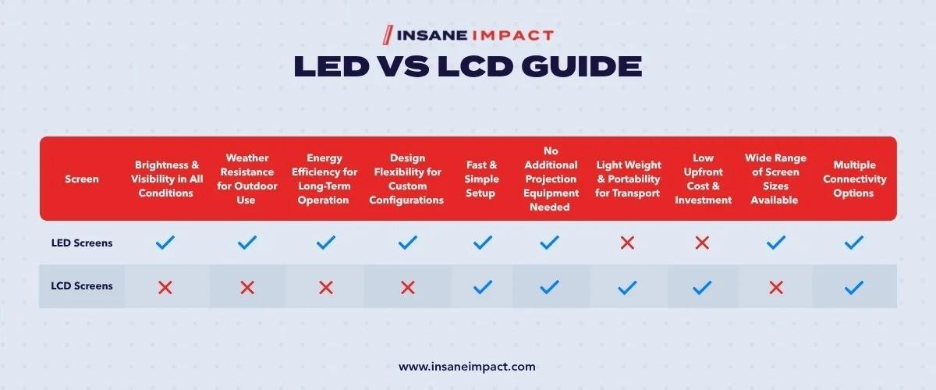
Feeling overwhelmed with choosing the best LED screen for your event? With countless features, specifications, and logistical details, it's easy to get lost in the technical jargon. When it comes down to LED vs. LCD displays, critical factors like viewing distance, screen location, and the content you plan to show all come into play. Feeling even more overwhelmed? Let’s consult the experts.
At Insane Impact, our team of approachable LED experts is here to guide you. We’ve set the standard for high-performance LED video walls, and we’re committed to helping you select the perfect display for your event.
Let's break down the important factors you need to consider.
The clarity of any screen is determined by its pixel pitch. In simple terms, pixel pitch is the distance between the center of one pixel and the center of its neighbor. This measurement is crucial because it determines the display’s sharpness and the optimal viewing distance. A smaller pixel pitch results in higher resolution and allows for closer viewing, while a larger pixel pitch is suited for viewing from a distance.
Consult the chart below to determine the ideal pixel pitch for your needs.

LED vs LCD vs OLED: Understanding the New Era of Display Technology
One consistent thing about display technology? It continues to advance. Enter: OLED (Organic Light-Emitting Diode). While LED and LCD dominate large-scale applications, OLED is becoming popular in high-end retail, corporate, and hospitality signage. While each display technology has its strengths, understanding their practical applications can help you choose the right solution for your event or space:
Not as familiar with OLED as the other two? Here are a few advantages and limitations to this new technology:
For event displays, programmable signs outdoor, and digital scoreboards, LED remains the strongest choice. OLED shines in smaller, indoor environments like retail stores, hotels, or healthcare facilities, where aesthetics outweigh brightness needs.
When choosing a display technology for events, LED consistently outperforms LCD with superior image quality, exceptional reliability, and more streamlined maintenance. Here’s a detailed breakdown of how these technologies compare:

LED screens have become common solutions in the large event category space with their optimal picture resolution and capability to emit high light levels.
Overall, an LED screen should be used for events requiring a brightly lit display that’s visible whether guests are nearby or hundreds of feet away.
LCD screens are typically seen in smaller, more consumer-driven displays, such as computer monitors or TVs. This screen option is ideal for small applications where an affordable, but high-quality display is needed. Additionally, with a wide range of connectivity options, these screens are versatile.
Benefits of LCD Screens
Cons of LED Screens

Reliable Performance, Every Single Time
To most people, LED and LCD screens might look similar, but they perform very differently. While LCD screens are a cost-effective choice for standard indoor use, LED displays deliver the brightness, durability, and clarity needed for high-impact events.
With vibrant color, long life, and easy maintenance, LED is the best choice for demanding applications. It delivers reliable, professional results every time. This makes LED ideal for:
Explore more real-world examples on our Industries We Serve page.
No Screen Burn, No Worries
Unlike LCD or OLED displays, LED screens are immune to screen burn (also known as image retention). This issue occurs when static graphics such as logos or tickers remain on-screen for long periods and leave behind a faint "ghost" image.
LED’s self-refreshing pixels and high refresh rate prevent this problem, keeping visuals crisp and consistent over time. This makes them ideal for programmable outdoor signs, digital scoreboards, and conference room signage that display long-running or static content.
Curious how your current screen stacks up? Try performing a simple Screen Burn Test to see why LED is the more reliable choice.
Built for the Elements: Understanding IP Ratings
When digital signage needs to perform rain or shine, IP rating becomes a crucial factor. This rating measures how resistant a display is to dust and water.
Choosing a display with the right IP protection ensures your investment withstands the elements. Want to learn more? Read our blog IP Ratings 101 – Everything you Need to Know.
If you’re still weighing your options, don’t sweat it. Our team of approachable LED experts is here to help you choose the best digital signage for your needs.
If you’re ready to rent an LED screen but want a little more information, read our blog, Guide to First Time Jumbotron Rental. If you’re ready to take the leap and chat with a member of our sales team, reach out today! As the nationwide leader of mobile LED screen trailers and video wall installations, we’re confident we have a solution to match your needs. Find out how we can help you make an impact on your audience.